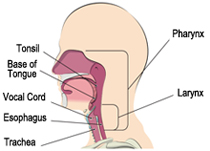Head and Neck Robotic Surgery
Head and neck surgeon Greg Farwell highlights some of the benefits of using a robotic-assisted surgical system for patients at UC Davis Medical Center. Read more about robotic surgery in our FAQs.
UC Davis Medical Center was the first hospital in Northern California to offer robotic-assisted surgery for conditions of the head and neck. Gregory Farwell, and Arnaud Bewley, professors of otolaryngology and director of head and neck oncology and microvascular surgery, use a surgical robot to aid in the removal tumors of the throat (pharynx), voice box (larynx) and mouth (oral cavity), which includes the tongue, base of tongue, tonsils, uvula, palate, epiglottis and hypopharynx.
Throat tumors, especially those of the tonsils and base of the tongue, have become increasingly common. Historically, such tumors required extensive, invasive surgeries that included removal or splitting of the lower jaw and a microvascular transfer of bone or soft tissue to reconstruct the area. More recently, utilizing a surgical laser and telescopes, UC Davis became a leader in minimally invasive procedures to remove throat-related tumors. Today, using their new robotic-assisted equipment, UC Davis surgeons have further advanced minimally invasive surgeries to enhance patient care.
 Robotic-assisted surgery. No incision, no scars.
Robotic-assisted surgery. No incision, no scars.
 Traditional surgery with extensive incision.
Traditional surgery with extensive incision.
The transoral robotic procedure enables surgeons to work from within a patient’s mouth, avoiding external incisions in the neck and jaw that can leave an individual with permanent scarring and difficulties in eating, speaking and swallowing. The latest robotic technologies allow Farwell and his colleagues to offer delicate, state-of-the-art procedures to more patients in more types of cases.
“Compared to our earlier approaches of radical surgery and major chemotherapy/radiation therapy, when we use our robot, patients typically have a better functional outcome and can heal in a shorter time period,” says Farwell, who specializes in laser and robotic microsurgeries of upper aero-digestive tract as well reconstructive procedures to repair traumatic and oncologic (tumor) defects. “While some patients still require traditional, aggressive surgery to give them the best chance of a cure, increasingly we offer patients a minimally invasive alternative using the robot. In select patients, we can even use it for tumors farther down the throat around the larynx and hypopharynx.”
Potential Benefits to Patients
- Less blood loss
- Good cancer control
- Reduces or avoids need for chemo-radiation therapy
- Eliminates need for tracheotomy
- Lessens complications
- Reduced hospital stay
- Faster recovery and return to normal speech and swallowing
- No visible scarring or disfigurement
Robotic Head and Neck Procedures

Dr. Farwell in the operating room.
With the high-precision robotic system, surgeons place slim instruments and a video camera into a patient’s mouth to reach the base of the tongue, tonsils and other areas of the throat. During the operative procedure, the surgeon sits at a controlling console across from the patient. An assisting surgeon remains at the patient’s bedside to re-adjust the instruments and camera as needed. The operating surgeon has a three-dimensional view of the operative field and controls the robotic instruments from the console, which replicate the surgeon’s hand movements with precision. The console’s computers track the hand movements, digitizing the information and enabling extraordinary surgical accuracy. The robot is not pre-programmed; it is entirely under the control of the surgeon.
The robotic-assist system provides surgeons with better-quality vision, enhanced dexterity and easier access to difficult-to-reach areas of the throat. It also avoids the disfiguring and traumatic aspects of traditional open surgery. For people suffering head and neck cancers, the benefits can be significant. Robotic procedures leave the jaw intact, avoid cranial nerves and shorten recovery times while also lowering the risk of complications.

 “When Dr. Farwell described the common surgical method previously used, I felt very fortunate that I could benefit from the robotic surgery and also to be under his care.” — John Gallagher, CA
“When Dr. Farwell described the common surgical method previously used, I felt very fortunate that I could benefit from the robotic surgery and also to be under his care.” — John Gallagher, CA